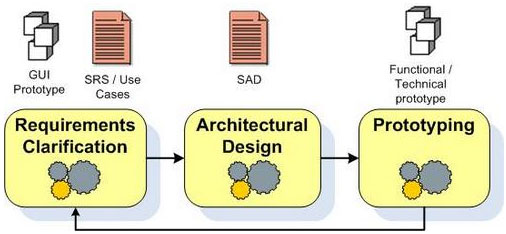
Project
Execution
The following elements are usually included into standard outsourcing project execution process.
Kick-off Meeting
A good practice is to say “Hello” at the start of each project. We establish kick-off meeting at the project beginning when each party can present themselves. Additionally some initial questions may be coordinated, like reporting terms, required formats etc.
Project Requirements Clarification

You can be sure that project is already 50% successful if an offshore team understands your requirements correctly. That’s why our analysts are always in close interaction with customer representatives. Of course it is impossible to define all the nuances of the project on its first phase, so the process of requirements detailing is built iteratively.
Clients provide us with business needs or ideas and our specialists transform them into formal Software Requirements Specifications and Use Cases. Also, it is important to create GUI prototype (markup) to be able to see what the system will look like – usually it helps to make requirements more clear.
Technical & Functional prototyping / Architectural design
We regularly update our software solutions to deliver features that have been requested by our customers and all our solutions are designed to be easy to use and configure. We pride ourselves on understanding the needs of our customers and have been supplying quality, reliable software solutions for over fifteen years.We are also a leading automation company in Hyderabad dealing in biometric attendance systems,access control systems,Parking management solutions and gate automation .
Implement & Test the Solution
This stage is a stage of transferring project requirements into a working system.
The best practice here is to deliver regular versions of product, so Client could see the progress in real time, and also to continuously improve the product quality. Implementation and V&V (testing) go together and establish a development cycle until the scope is ready and the quality is accepted.

Acceptance testing on customer side
In Haritha Technologies we use comprehensive set of tests and quality control methodologies to guarantee final product quality. Nevertheless, your acceptance of provided results is a crucial point in the project.
Support phase
After the project is completed we enter the support phase. Its duration should be defined in the Teaming Agreement. Usually it means that during the support phase all arising problems will be fixed for free.
Planning & Risks management
Preliminary project plan and risks list should be created during project estimation phase. However it is impossible for foresee all possible risks as well as it is quite difficult to create a well-detailed plan before project is up and running. These activities are rather continuous. In project due course project manager regularly reviews list of risks, defines new risks and sort out existing ones, updates project plan with actual work, modifies list of tasks in accordance to made decisions and established priorities, and so on.
Reporting
In Haritha Technologies we have standard set of reports we usually use to update client about project progress, problems that need resolution, available defects etc. By default, the following reports are used:
- Weekly project status report
- Report on project plan / Updated project plan
- Available Defects report / Fixing dynamics
- Other
As you can see, working with an offshore outsourcing company is just a bit more difficult than working with a local consultant. For more information on Haritha Technologies outsourcing services, please contact us.
